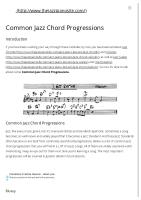How To Practice Playing Jazz - The Jazz Piano Site [PDF]
(http://www.thejazzpianosite.com/) How To Practice Playing Jazz Putting Theory into Practice One of the most common
32 0 186KB
Papiere empfehlen
![How To Practice Playing Jazz - The Jazz Piano Site [PDF]](https://vdoc.tips/img/200x200/how-to-practice-playing-jazz-the-jazz-piano-site.jpg)
- Author / Uploaded
- Mbolafab Rbj
Datei wird geladen, bitte warten...
Zitiervorschau
(http://www.thejazzpianosite.com/)
How To Practice Playing Jazz Putting Theory into Practice One of the most common questions I get asked is ‘Well, all this theory is well and good; but how do I put all this theory into practice? How should I actually practice playing Jazz?’ So let’s quickly address this question. Most of the Giants of Jazz practiced every day, for hours at a time. John Coltrane was fascinated by scales so he practiced them for hours, running up and down each scale in every key Bill Evans spend hours practicing every possible chord, in every possible inversion, in every possible voicing, in every possible key Charlie Parker famously practiced the song ‘Cherokee’ for months, if not years. He learned to play it in every key
Building up and improving your nger technique and speed is important. And the way you do this is by tediously repeating scales and chords ad nauseum. Slowly at rst, with a metronome, then gradually increasing the speed. There are also plenty of ‘ nger exercise’ textbooks out there for you to use (I recommend the classic The Virtuoso Pianist by Charles-Louis Hanon).
But personally, I think playing actual songs is much more interesting and useful than just playing scales, arpeggios or nger exercises. Now, you obviously need the latter, but once you have a minimum level of competency then I think playing songs is more enjoyable and valuable.
Free Guitar Chords Includes over 3000 of the most commonly used guitar chords. guitaristsreference.com
How to Practice Playing Jazz So I recommend the following exercises: Play a II-V-I in every key going around the Circle of Fifths So for example, start with a II-V-I in D (Em7, A7, DMaj7) then a II-V-I in G (Am7, D7, GMaj7) then a II-V-I in C (Dm7, G7, CMaj7) and so on Play II-V-I’s with di erent chord voicings (http://www.thejazzpianosite.com/jazzpiano-lessons/jazz-chord-voicings/) Play II-V-I’s with left hand only chord voicings and improvising with your right hand Do the same exercise but moving down in semitones Do the same exercise but with another common jazz chord progression (like I-VI-IIV, or 12 Bar Blues, etc.) Learn a (simple) Jazz Standard in every key Play the Standard with left hand only chord voicings while playing the melody in your right hand Play the Standard with two handed chord voicings which combine chords and melody Play the Standard with left hand only chord voicings while improvising in your right hand Reharmonize (http://www.thejazzpianosite.com/jazz-piano-lessons/jazzreharmonization/how-to-reharmonize-a-song/) the Jazz Standard Find a recording of a jazz solo that you like, and transcribe it – or at least nd some licks that you like and try replicate them Play along with a song or a backing track
So you’ve probably picked up on the pattern. Many Jazz songs change keys often and quickly and in odd ways (think Giant Steps and much of Wayne Shorter’s stu ). The best way to be a competent jazz pianist and be able to play these songs well, is to be comfortable playing in every key. Mind you, this is quite challenging and I’m certainly not competent in every key.
And the best way to learn how to improvise is to listen to lots of jazz and try transcribe and copy any
solos or licks that you like. Creativity is just disguised theft. Don’t be afraid to copy a solo note for note. Every great Jazz musician has transcribed a Charlie Parker solo and learned to play it note for note. In fact, some improvisations become so popular and well known that they become a song in and of themselves. For example, Coleman Hawkin’s solo over Body and Soul became so popular that it has been arranged into a song (by Benny Carter), and the melody has even had lyrics added to it (by Eddie Je erson).
Practice Tips I’ll close with some nal practice tips: Practice everything – scales, licks, voicings, improvisation and songs – in every key, especially your weak keys. Accuracy is more important than speed – so practice everything slowly. Speed will come naturally if you are accurate. Practice improvising slowly and gradually build up the speed – this will help you learn to think fast. There’s no point playing a lightning fast solo if all you’re doing is spewing out cliché licks and ri . You want to be creative, even at a fast tempo – that requires you to think fast, which rst requires you to play and think slow. Listen to and transcribe everything Play along with songs and backing tracks Record yourself and listen back to it – see what you like and dislike And nally, don’t be afraid to make mistakes. Mistakes are what makes Jazz interesting.
Free Guitar Chords Includes over 3000 of the most commonly used guitar chords. guitaristsreference.com
How to Practice Playing Jazz
>> NEXT LESSON >> (/jazz-piano-lessons/jazz-chord-progressions/contrafacts)
Music Lessons in Ballymena - Music Lessons NI Music lessons in Ballymena including Piano lessons, Guitar lessons and more ballymenaschoolofmusic.co.uk
OPEN
Search The Jazz Piano Site Search …
Donate While all my lessons are free, if you nd them useful please consider donating to help keep them coming. (https://www.paypal.com/cgi-bin/webscr? cmd=_donations&business=DUZ6VARAK7VAE&lc=AU&item_name=Walk%20That%20Bass¤cy_c ode=AUD&bn=PP%2dDonationsBF%3abtn_donate_LG%2egif%3aNonHosted) Home (http://www.thejazzpianosite.com) Donate (http://www.thejazzpianosite.com/donate/) Resources (http://www.thejazzpianosite.com/resources/) Privacy Policy (http://www.thejazzpianosite.com/privacy-policy/) Sitemap (http://www.thejazzpianosite.com/sitemap/)
Theme by Tesseract (https://tesseracttheme.com)
(https://tesseracttheme.com)









